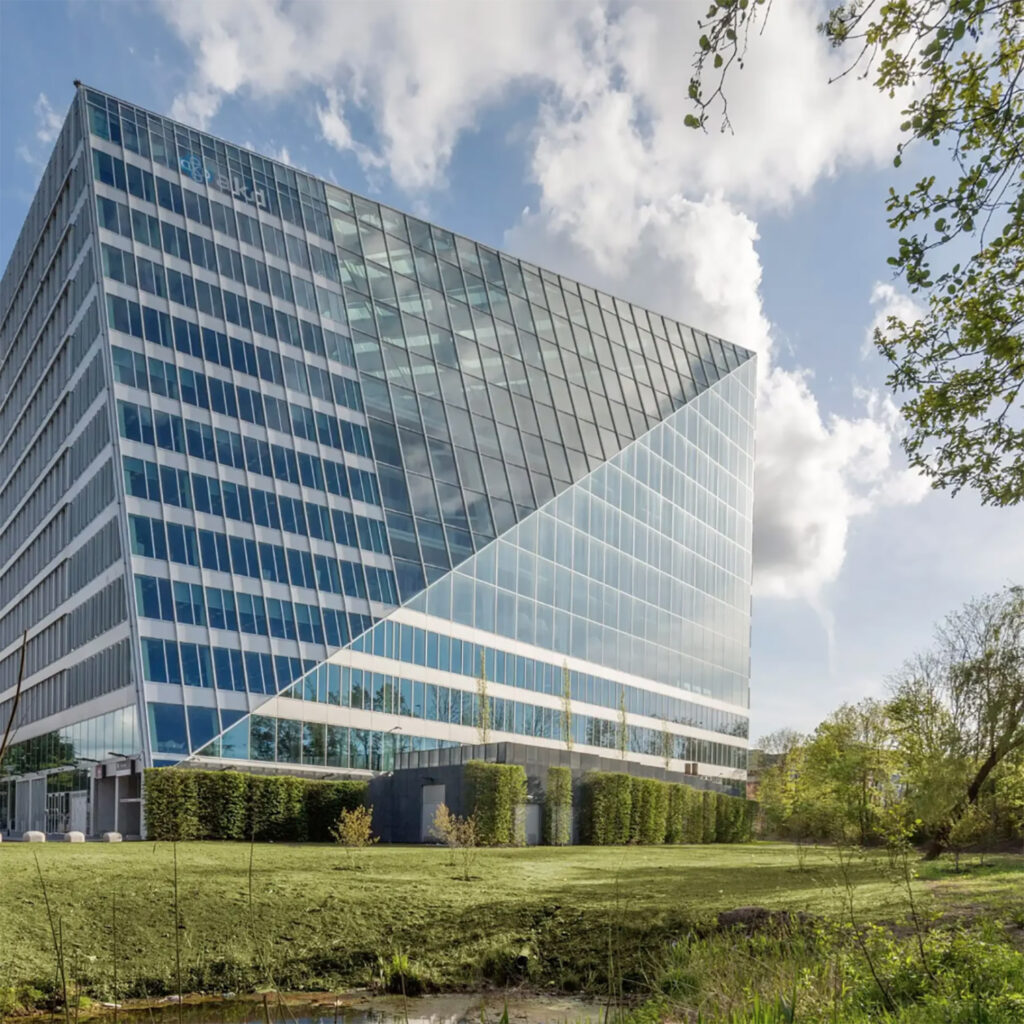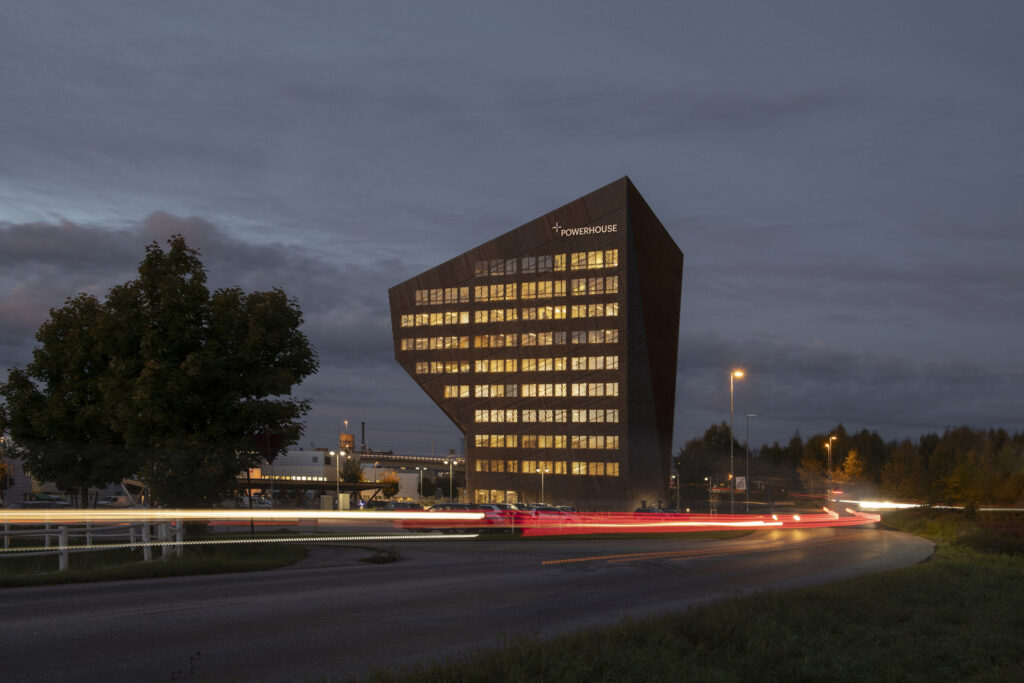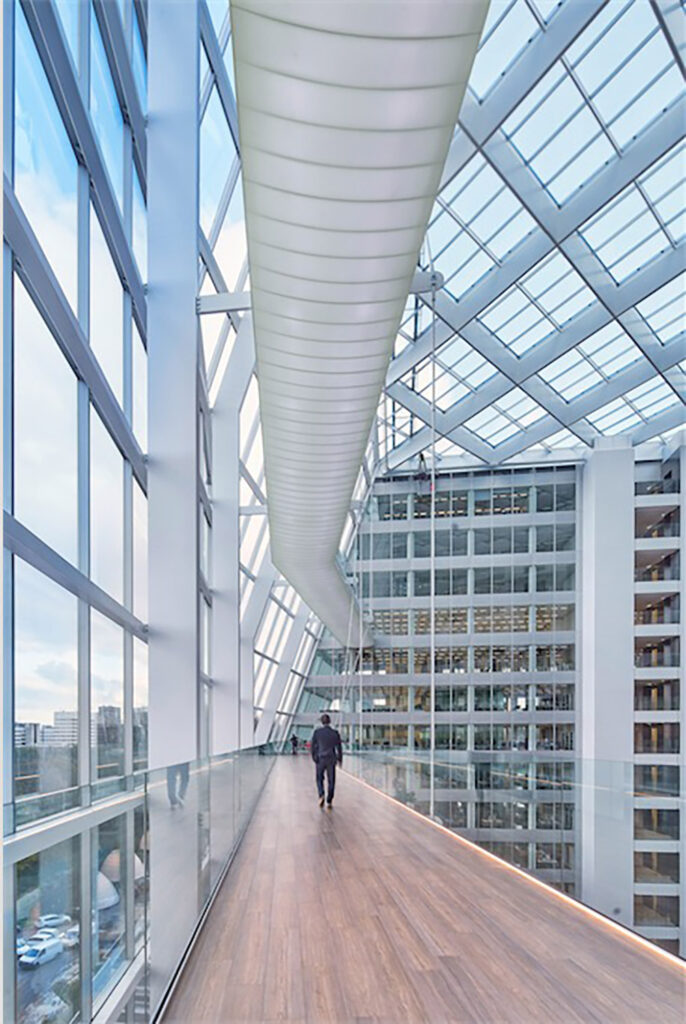IoT-enabled building facades use sophisticated sensor networks (temperature, humidity, air quality, light, occupancy, pressure, and wind) to create responsive architectural systems. Through wireless networks and AI-powered analysis, these smart buildings automatically adjust to environmental conditions, resulting in improved energy efficiency and occupant comfort. Facade engineers and architects play a crucial role in integrating these technologies, balancing technical requirements with aesthetic design while ensuring optimal system performance.
When Buildings Come Alive:
IoT’s Revolution in Facade Design
Welcome to the world of IoT-enabled facades, where building envelopes breathe, think, and respond like intelligent membranes, pulsing with data, communication, and adaptive intelligence.
This parallel to living organisms is deeply rooted in function, not mere metaphor. The walls themselves demonstrate this through their intricate networks of sensors and smart technologies that interact tirelessly 24/7 with their environment, the evidence is astonishing.
Buildings can now automatically adjust their internal systems based on external conditions. Monitoring temperature fluctuations, tracking air quality, measuring light intensity – all in real-time. It’s akin to having an army of microscopic building doctors, constantly checking the health of the architectural system.
Too sunny? The shades adjust.
Air quality dropping? Ventilation kicks in.
Occupancy low? Energy consumption reduces.
This isn’t science fiction for facade engineers and architects – it’s happening right now in cutting-edge architectural projects around the globe.
Smart Skin Sentinels:
Mapping Envelope Detector Types
Temperature and Humidity Sensors
Temperature sensors provide real-time data on thermal conditions both inside and outside the building, enabling precise control of HVAC systems and adaptive facade elements. Strategically placed within wall cavities, near windows, and on exterior surfaces, they typically use thermistors or thermocouples to measure ambient temperature.
Humidity sensors detect moisture levels in the air, which is crucial for maintaining optimal indoor air quality and preventing condensation issues. Modern humidity sensors often use capacitive or resistive sensing elements that change their electrical properties in response to moisture levels.
Air Quality Sensors
Air quality sensors are becoming increasingly important in smart building envelopes, especially in urban environments. These sensors monitor various pollutants and particulates to ensure a healthy indoor environment.
Common types of air quality sensors include:
- Particulate matter (PM) sensors
- Carbon dioxide (CO2) sensors
- Volatile organic compound (VOC) sensors
- Nitrogen dioxide (NO2) sensors
These sensors can trigger adaptive responses in the building envelope, such as increasing ventilation rates or activating air purification systems when pollutant levels rise. In some advanced systems, air quality data from the facade can also inform occupants about outdoor conditions and suggest optimal times for natural ventilation.
Light and Occupancy Sensors
Already widely used in façade engineering for a long time, light sensors measure illuminance levels and are crucial for optimizing daylighting strategies and reducing energy consumption from artificial lighting. These sensors can be integrated into smart windows or shading systems to automatically adjust tint or position based on sunlight intensity and glare conditions.
Occupancy sensors detect the presence of people in a space, typically using passive infrared (PIR) or ultrasonic technology. When integrated into building envelopes, these sensors can:
- Adjust HVAC and lighting settings based on occupancy
- Inform security systems
- Provide data for space utilization analysis
The combination of light and occupancy sensors enables dynamic facade responses that balance energy efficiency with occupant comfort and productivity.
Pressure and Wind Sensors
Pressure sensors measure air pressure differences across the building envelope, which is critical for understanding and controlling air infiltration and exfiltration. These sensors can detect pressure imbalances that may lead to drafts, energy loss, or moisture issues within wall assemblies.
Wind sensors, including anemometers and wind vanes, measure wind speed and direction. This data is valuable for optimizing natural ventilation strategies, controlling adaptive shading systems, and ensuring the safety of operable facade elements in high-wind conditions.
Network Architecture:
The Digital Nervous System of Smart Facades
Wireless Sensor Networks (WSNs): A Technological Revolution
Wireless Sensor Networks have transformed architectural spaces from static structures into dynamic, responsive organisms. Each sensor node acts like a specialized cell in a complex biological system. They communicate, share information, and respond to environmental changes with remarkable sophistication. Temperature fluctuations, humidity levels, air quality – nothing escapes their watchful gaze.
The Computing Dilemma: Edge vs. Cloud
The battle between edge computing and cloud-based systems is like choosing between a nimble sports car and a powerful mainframe computer. Edge computing offers immediate, localized processing – think of it as the building’s rapid-response team. Data gets analyzed on-site, reducing delays and protecting sensitive information.
Cloud systems, meanwhile, represent the grand library of architectural intelligence. They store massive datasets, run complex analytics, and provide insights that could revolutionize building design. Imagine a system that learns from thousands of buildings, predicting maintenance needs before they become problems.
The smartest approach is probably a hybrid model that combines the best of both worlds, like having a local expert with access to a global knowledge network.
Protocols: The Language of Smart Buildings
Data transmission protocols are the linguistic code of these intelligent systems. BACnet speaks the universal language of building automation, while Modbus offers straightforward, reliable communication. Newer protocols like LoRaWAN and Zigbee bring the magic of low-power, long-range connectivity.
Selecting the right protocol is an art form. It’s about understanding the unique DNA of each building, its specific needs, and its future potential.
Data Collection and Analysis
The Digital Heartbeat of Intelligent Buildings
Big Data Processing: Decoding the Building’s DNA
As buildings become more intelligent, they generate vast amounts of data. For example, the U.S. Department of Energy’s Building Performance Database (BPD) alone contains information on over 870,000 buildings. This wealth of information presents both a challenge and an opportunity.
Like a digital detective, Big Data analytics is uncovering hidden patterns and relationships that might escape human observation and transforming raw information into actionable intelligence: optimizing energy consumption, predicting maintenance needs, enhancing occupant comfort, and illuminating pathways to achieving sustainability goals.
Machine Learning and AI: The Cognitive Revolution in Building Management
Not a surprise: Artificial Intelligence is rewriting the rules of building performance. These aren’t just algorithms; they’re digital oracles predicting and preventing issues before they emerge.
Machine learning algorithms can identify complex, non-linear relationships between energy demand and various factors. This capability enables predictive maintenance, where potential issues are identified before they escalate, preventing downtime and optimizing energy-consuming systems. Buildings can now adjust energy usage during peak times or dynamically allocate resources to reduce overall energy demand.
As a result, the numbers are staggering. Some AI implementations have demonstrated energy savings up to 36.5%. In residential structures, AI implementation has demonstrated energy and cost reductions ranging from 5.05% to 34%, while in public buildings savings range from 10% to 58.5% – a testament to the transformative power of intelligent systems.
Integration with Building Management Systems:
The Facade engineer’s Digital Reflexes
As buildings become intelligent entities, they represent sophisticated organisms where microscopic technological sentinels communicate instantaneously with the Building Management System (BMS), creating a responsive architectural intelligence.
The communication infrastructure resembles a high-speed neural network. Machine learning algorithms work like invisible conductors, while data races through wireless protocols, transforming raw sensor information into actionable insights.
With this new layer of sophistication, historical data becomes a predictive tool, revealing performance patterns and potential optimizations.
As we move forward, the convergence of IoT technology, artificial intelligence, and architectural design will continue to evolve, becoming increasingly sophisticated in their ability to respond to both environmental conditions and human needs, while playing a crucial role in creating more sustainable, efficient, and comfortable built environments.
Useful links:
https://www.mdpi.com/2076-3417/14/3/1145
Case study:
The Edge, Amsterdam, The Netherlands (2024)
Architects: PLP Architecture
The Edge, designed by PLP Architecture, is renowned as one of the smartest and most sustainable office buildings globally. A key innovation driving its efficiency is the integration of sensor networks for real-time environmental data collection. Thousands of IoT sensors continuously monitor temperature, humidity, light levels, and occupancy, enabling dynamic energy optimization.
This data-driven approach enhances comfort while significantly reducing energy consumption. The building’s smart lighting system, developed with Philips, adjusts brightness based on occupancy and daylight availability, cutting electricity use by 80%. Additionally, sensors optimize ventilation and heating, ensuring air quality and thermal comfort while minimizing waste. By leveraging sensor networks, The Edge exemplifies the future of sustainable architecture—where real-time data enhances both user experience and environmental performance. This advanced monitoring system contributes to the building’s BREEAM Outstanding rating, setting a benchmark for intelligent, energy-efficient design.

Powerhouse Telemark, Porsgrunn, Norway (2020)
Architects: Snøhetta
Powerhouse Telemark, designed by Snøhetta, exemplifies next-generation sustainable architecture by integrating sensor networks for real-time environmental data collection. This energy-positive office building, located in Porsgrunn, Norway, utilizes advanced sensors to monitor indoor climate, air quality, and energy consumption. These sensor-driven insights enable automated adjustments to lighting, ventilation, and heating, ensuring maximum energy efficiency while maintaining occupant comfort. The collected data also informs long-term sustainability strategies, supporting predictive maintenance and adaptive energy management. Powerhouse Telemark demonstrates how sensor networks can revolutionize environmental performance, paving the way for smarter, more sustainable architecture.

As the Editor of FacadeToday.com, I merge my passion for Design, Architecture and Technologies with three decade of experience collaborating with entrepreneurs across many industries. My career has centered on fostering innovation, scaling business opportunities, and bridging gaps between technical experts, business developers, and creative visionaries. I thrive at the intersection of sustainable solutions, material advancements, and smart technologies, curating insights on themes like energy-efficient facades, smart tech, and advanced manufacturing. With a commitment to lifelong learning, I aim to empower architects and facade engineers by translating innovations into actionable knowledge, driving the industry forward through purposeful connectivity and cutting-edge practices.






